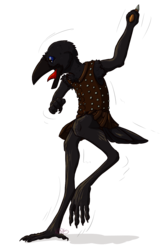Sign In
ClosePLEASE NOTE! ZINNAGON ARE NOT AN OPEN SPECIES! MEANING YOU CAN NOT MAKE ONE WITHOUT PRIOR PERMISSION!
Information!
Bones
A: Narrow head with nostrils located above & behind the eye, near where the antennae attach.
B: Sturdy wing bones, with two sub-phalanges to support the fore-membrane of the wing.
C: Five fingers, with two thumbs. Fairly dexterous, not quite as dexterous as a human hand, but still decent enough.
D: Large keep to support the flight muscles.
E: Fairly maneuverable fore-limbs, able to twist similar to a human arm, though less maneuverable in the shoulder area.
F: Large hind limbs, good for leaping.
G: A pseudo hip/shoulder point where the tail-fin muscles anchor.
H: Large hind claws to help grip while climbing. There are two spurs located high up on the rear leg.
I: The end most length of the tail is very flexible, & prehensile. The rest is very still, & nearly unable to swing left & right.
J: Spurs on rear limb located high up, useful for gripping while on vertical surfaces. Unable to really "grab" anything though.Muscles
A: Large eyes, with excellent binocular color vision.
B: Short, semi-mobile ears. Range of motion is rather small.
C: Strong thick membrane stretched across wings.
D: Strong fore-limbs for climbing & gripping prey.
E: Strong rear limbs for leaping & climbing.
F: Minuscule scales cover their entire body.Feathering
A: Commonly, feathers will grow atop the head & down the neck. The ears will also commonly have feathers, amplifying what little mobility they have.
B: Wings are only feathered on their dorsal side, generally with a larger, sturdier feathers then else where.
C: Feathers are also commonly found along the back & chest, but usually not covering the back completely.
D: The limbs can also have some feathering along the joints most commonly.
E: Similar to the wings, the tail fins are only feathered on top.
F: Sometimes, the tail end will be covered in feathers. When this occurs, it often interferes with the dexterity of the prehensile part of the tail.Antennae
Get their own burble. In that Zinnagon antennae come in many shapes & sizes. Though the more "unique" they are, the less likely they are to be seen. Some fairly common ones are shown here.
Zinnagon antennae, as noted in the previous ref, detect scent extensively & sounds to a degree. They're sensitive to pressure differences, allowing them to detect vibrations in the air, so a zinnagon whose ears have ceased to work properly won't be able to hear truly, they will still be able to detect louder sounds.
If you have any questions just ask & I'll do my best to share the answers. :D
But please remember, this is not an open species. Please do not create one without permission. 83
Art & Species (c) Me! 83
ps...hope the gif portion of this works. 8D
Submission Information
- Views:
- 378
- Comments:
- 0
- Favorites:
- 1
- Rating:
- General
- Category:
- Visual / Animation




